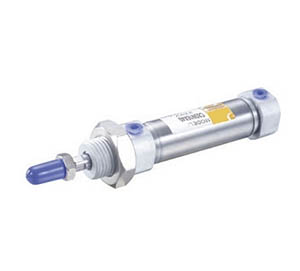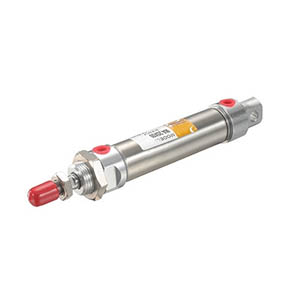Single VS Double Acting Pneumatic Cylinders: What are their Differences?
There is a wide range of cylinder types, and cylinder designs vary according to their application and end-use industry. These cylinder types differ in certain components. The more commonly used pneumatic actuators in manufacturing consist of a piston and rod moving within a closed cylinder and are designed to move in a straight line to provide linear motion. This type of pneumatic linear actuator is used in various industrial sectors, factory automation, and packaging, as well as transportation and life science applications. Single-acting cylinders and double-acting cylinders are common types of cylinders.
Basics differences
Single acting cylinder
Single-acting cylinders are divided into spring return and external force return. Pneumatic actuators are mainly divided into linear reciprocating type, swing type, and continuous rotary type. According to structure, function, and shape, there are many kinds. Single-acting cylinders have only one cavity that can be input with compressed air to achieve movement in one direction.
A single-acting cylinder provides power to only half of its actuation output range, and this type of cylinder is typically used where torque loads are experienced only on the activation stroke. For example, on a metal stamping machine, only the reverse stroke is required to return the cylinder to its neutral position.
Good examples of these are spring return actuators and solenoid valves, where the cylinder is reset by spring tension once the power stroke is complete. Its piston rod can only be pushed back by an external force. Usually, these external forces are spring force, diaphragm tension, gravity, etc. The spring recovery speed of the single-acting cylinder is stable and is not affected by changes in air pressure. Single-acting is more functional than double-acting. The single-acting cylinder functions reliably and stably. The medium can only be pushed in one direction, the pressure is provided, and the operation is simple and easy to understand. Small size, easy to carry, low price, affordable.
Double acting cylinder
The double-acting cylinder is a mechanical device that provides power for the secondary mechanism to act in both directions. This is in contrast to single-action or spring-return cylinders and solenoids, which function only in one direction on the power stroke, and rely on a second energy source to reset or return the cylinder.
Double-acting cylinders are generally driven by electric motors or compressed air. The electric double-acting actuator provides bi-directional force through the motor reversing control circuit. The compressed gas has reverse inlet valves that direct the propellant to one side of the braking mechanism or the other.
Working principle
Single acting cylinder
Single-acting cylinders work by transferring hydraulic fluid or output force in one direction only. In a cylinder, the piston rod can be pushed outwards but cannot be pulled back, so a force in the opposite direction is required to return the piston rod to its original position. Traditionally, single-acting cylinders can be supplemented with auxiliary components such as pumps, motors, or internal springs. Only one end enters (exhausts) the air, the structure is simple, and the air consumption is small. Single-acting cylinders have a port for connecting hydraulic cylinders, and hydraulic hose connectors.
The single-acting cylinder is reset by spring force. And part of the compressed air energy is used to overcome the spring force or diaphragm tension, thus reducing the output force of the piston rod. Springs, diaphragms are installed in the pneumatic cylinder, and the stroke is generally short. Compared with double-acting cylinders of the same volume, the effective stroke is smaller. The tension of the return spring and diaphragm of the pneumatic cylinder changes with the deformation, so the output force of the piston rod changes during the traveling process. Single-acting piston cylinders are mostly used in occasions with short strokes and low requirements on thrust and speed, such as air suspension, positioning, and clamping devices, and single-acting piston cylinders can be used in long-stroke and high-load occasions.
Double acting cylinder
In contrast, double-acting cylinders offer greater complexity. Unlike single-acting cylinders,  they are capable of transmitting hydraulic fluid or output force in both extend and retract directions. Ports are located at both ends of the cylinder and allow the piston rod to move forward and backward.
they are capable of transmitting hydraulic fluid or output force in both extend and retract directions. Ports are located at both ends of the cylinder and allow the piston rod to move forward and backward.
This movement is caused by port alternation, with one end receiving pressure, generating thrust, and performing a push-pull motion. Since the double-acting cylinder has compression and tension, no external power supply is required, so it can meet larger industrial systems. As such, they are the most commonly used cylinder type on the market.
When comparing single-acting cylinders and double-acting cylinders, the most obvious difference is the number of couplers or connection ports. The double-acting cylinder is a mechanical device that provides power for the secondary mechanism to act in both directions. This is in contrast to single-action or spring-return pneumatic cylinders and solenoids, which function only in one direction on the power stroke, and rely on a second energy source to reset or return the cylinder.
Double-acting cylinders are generally driven by electric motors or compressed air. The electric double-acting actuator provides bi-directional force through the motor reversing control circuit. The compressed gas has reverse inlet valves that direct the propellant to one side of the braking mechanism or the other.
Double-acting cylinders have a port at each end and move the piston back and forth by alternating the port receiving high-pressure air, which is necessary when a load must be moved in both directions, such as opening and closing a door. Air pressure is applied alternately to both ends of the piston.
When looking for equipment configured to move loads in both directions, double-acting cylinders are a useful application when your machine requires multiple movements. Unlike single-acting cylinders, double-acting cylinders retract without a spring.
Double-acting cylinders use hydraulic power to extend and retract. In double-acting hydraulic cylinders, when hydraulic fluid is pumped into the top port at high pressure, the plunger retracts, forcing the plunger back to its original position. This can be done quickly if desired, or step-by-step with precise control. The double-acting cylinder is more energy-saving, with high operation accuracy and high precision, because the structural design can do push-pull action to generate air pressure, and the function is more complicated.

